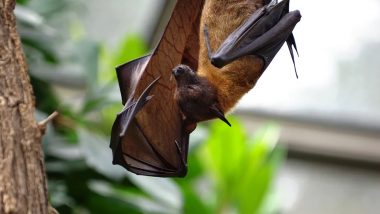Scientists have discovered six new coronaviruses in Myanmar-based bats. They were found be from the same family as the SARS-CoV2 which caused COVID-19, however, are not closely genetically related to the current pandemic. The new viruses were found in three different species: the Great Asiatic yellow house bat, the wrinkle-lipped free-tailed bat and the Horsefield's leaf-nosed bat. The team said that more studies will be required to determine if the newfound coronaviruses have 'the potential for transmission across species to better understand the risks to human health'. Bats Are Possible Source of Coronavirus? How Do They Survive the Virus While Humans Are Succumbing to the Deadly Disease.
As per reports, researchers conducted by the Smithsonian's Global Health Program hopes to 'understand the diversity of coronaviruses in bats and inform global efforts to detect, prevent and respond to infectious diseases that may threaten public health, particularly in light of the ongoing COVID-19 pandemic.'
Marc Valitutto, a former wildlife veterinarian with the Smithsonian's Global Health Program and lead author of the study, said in a statement, "Viral pandemics remind us how closely human health is connected to the health of wildlife and the environment. Worldwide, humans are interacting with wildlife with increasing frequency, so the more we understand about these viruses in animals—what allows them to mutate and how they spread to other species—the better we can reduce their pandemic potential."
For the research, the team gathered saliva and faecal samples from 11 different species of bats in parts of Myanmar, a country in Southeast Asia that borders Bangladesh and India. After tests, they were compared to other known coronaviruses, which resulted in six new ones. One was also found in other parts of Southeast Asia, but never before seen in Myanmar. For How Many Days Do Signs of COVID-19 Last? Here's How Long Individuals Tested Positive for Coronavirus Remain Contagious.
According to LiveScience, the names of the six coronaviruses include: PREDICT-CoV-90 (found in the Asiatic yellow house bat), PREDICT-CoV-47 and PREDICT-CoV-82 (found in the wrinkle-lipped free-tailed bat) and PREDICT-CoV-92, -93 and -96, which were found in the leaf-nosed bat.
Suzan Murray, director of the Smithsonian's Global Health Program and co-author of the study, said, "Many coronaviruses may not pose a risk to people, but when we identify these diseases early on in animals, at the source, we have a valuable opportunity to investigate the potential threat. Vigilant surveillance, research and education are the best tools we have to prevent pandemics before they occur."
According to a study by the Indian Council of Medical Research (ICMR) as potentially pathogenic coronavirus has been detected in Indian bats there is an urgent need to enhance screening for novel viruses in them. The study published in the Indian Journal of Medical Research says, "One Health approach with collaborative activities by the animal health and human health sectors in these surveillance activities shall be of use to public health."
R Gangakhedkar, the head scientist at Indian Council of Medical Research said, "According to the research in China, Coronavirus might have originated due to mutation in bats. Bats might have transmitted it to pangolins, from pangolins it got transmitted to humans." He added, "At the time when the Nipah virus occurred, we started an investigation on the Indian animals to see which all have the ability to spread such kind of virus. Here, we identified two Indian bats which have coronavirus. However, this kind of coronavirus did not generate from our bats."
Watch The Video Below:
#WATCH As per research in China, it was found that #Coronavirus might have originated due to mutation in bats. Bats might have transmitted it to pangolins, from pangolins it got transmitted to humans: R Gangakhedkar, Indian Council of Medical Research (ICMR) (1/2) pic.twitter.com/owq4MB9oJ7
— ANI (@ANI) April 15, 2020
The study authored by Pragya D Yadav says, "This would help in the development of diagnostic assays for novel viruses with outbreak potential and be useful in disease interventions. Proactive surveillance remains crucial for identifying the emerging novel viruses with epidemic potential and measures for risk mitigation." Coronavirus Mutated in Bats to Infect Humans: ICMR Cites Chinese Research.
The research found the presence of a bat coronavirus in bat species from Kerala, Himachal Pradesh, Puducherry and Tamil Nadu. The ICMR study for the first time has found the presence of a different kind of coronavirus, bat coronavirus (BtCoV) in two bat species from these four states.
The ICMR study states, "One Health approach with collaborative activities by the animal health and human health sectors in these surveillance activities shall be of use to public health. This would help in the development of diagnostic assays for novel viruses with outbreak potential and be useful in disease interventions. Proactive surveillance remains crucial for identifying the emerging novel viruses with epidemic potential and measures for risk mitigation." Indian Bats Don't Have Ability to Transmit Coronavirus: ICMR.
COVID-19 infected people were first reported in Wuhan, China in December 2019. Today, they have infected nearly every country in the world. As of Tuesday, there are more than 1.9 million confirmed cases and the death toll has surpassed 119,000. India has reported 11,933 positive cases of coronavirus, which has claimed 392 lives so far.
(The above story first appeared on LatestLY on Apr 15, 2020 09:26 PM IST. For more news and updates on politics, world, sports, entertainment and lifestyle, log on to our website latestly.com).













 Quickly
Quickly


